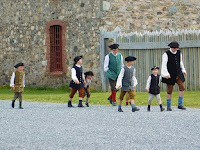Morning
brought an early breakfast along with stimulating conversation with our hosts
Joanne and Ben. We were soon joined by another couple of guests who were
also traveling from California. How strange was that! We all enjoyed telling
tales of traveling and funny guests. We loved this time, but the road called
again.
Today's journey would take us back into the beautiful national Park, then out
of the park headed south and east. Our host suggested a slightly longer but
very beautiful drive along the coast. This took us through some true small fishing villages that were so charming! We were again seeing colorful fishing boats. Many of these boats were lobster boats. They were tied up now because the lobsters season would not start until mid-Fall. The lobsters being served now had been caught much earlier and were held in cold water tanks. Healthy and ready to be eaten.
The lobster traps (also called lobster pots) were stacked neatly on the docks. We also saw them being moved along the highway. We were sure the fisherman were eager to get back on the water.
We
waited for our turn to go on a small ferry across a river. This saves a lot of
driving, and besides that it is always fun to go on a ferry!
Eventually, we got to our major event of the day: an amazing living historic
site: Louisbourg Fortress. (Incidentally, this was the furthest East we would drive and the furthest East we could drive in North America without using a ferry.) This is the largest historic site that has been
re-created in all of Canada. And it was impressive! The fort had many uses over
time, but was especially used to protect the fishing fleet which was bringing cod back to Europe. And, to protect the French from the British. When the British finally defeated the French
here, the fortress was reduced to no more than one stone high. The Canadian government decided to rebuild a
major portion of the fortress as a historical site.We so enjoyed the fine buildings and good re-enactors. Our first encounter with the “French soldiers” was as we tried to enter the fortress. We were challenged to state our business and questioned why we were speaking English. We were allowed to pass and then Dick had quite a conversation with the guard about the role of guards at such a military site in the 1600s.
There
were many re-enactors going about their business in the village within the
great stone walls. We were hungry so we
stopped in the local tavern for some food: a soldier's lunch.
We had a great vegetable soup and cheese and bread. The food was very basic at that time but tasted good to us this day.
Many of the re-enactors were children. They were simply walking around the village or playing games or accompanying adults. They seemed to be having a great time with their roles.
We
wandered further in the fortress and were delighted to find a French officer
leading a thief to the village center to be punished for stealing a bottle of
wine. It was quite a little
pageant. With great fanfare, the thief
was held to ridicule, the official reading the charges every 100 feet until
they reached the dock area. As the
punishment was decided, the thief played to the audience but was found guilty
and ordered to help tell stories
This
led to a highlight for Patti, getting to see a story theatre troop perform a
couple of folktales in English and French. They did Little Red Ridinghood and
also the Fisherman and his Wife. A terrific job! Go storytellers!!! The
fortress had so many things to offer that we could have stayed for a couple
of days. However, we still had an additional 260 miles to drive, so
off we went. Goodbye, Louisburg!
And then, hello, Halifax. We arrived at about 9:30 and were so very tired. Our AirBnB was beautifully located within walking distance of the key attractions. But, we were frustrated that there were not good parking options for our city apartment. This caused some real difficulties, but we worked it out and fell into bed. A long and good day... Both tired and ready for a good night's rest.
And then, hello, Halifax. We arrived at about 9:30 and were so very tired. Our AirBnB was beautifully located within walking distance of the key attractions. But, we were frustrated that there were not good parking options for our city apartment. This caused some real difficulties, but we worked it out and fell into bed. A long and good day... Both tired and ready for a good night's rest.


























































